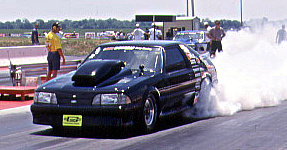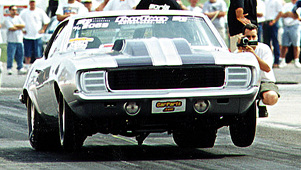SUPER STREET
 There
was a time when every racer with a warmed over street car and a nitrous
oxide injection kit could drive his or her car to a NMCA event, change
the tires, open the pipes, turn on the bottle and figure to be somewhat
competitive. Not anymore! This class has truly become the Pro Stock of
street legal racing. The basic rules of the class haven't changed much,
but the level of professionalism in applying the rules certainly has.
Super Street cars retain a stock appearance, a stock frame in the stock
position, a 50/50 weight distribution and remain limited to a 10.5 inch
wide slick. If the rules makers had stuck to both the spirit and letter
of the rules from the beginning this would still be a class where real
street racers could race, but they didn't and it isn't. There
was a time when every racer with a warmed over street car and a nitrous
oxide injection kit could drive his or her car to a NMCA event, change
the tires, open the pipes, turn on the bottle and figure to be somewhat
competitive. Not anymore! This class has truly become the Pro Stock of
street legal racing. The basic rules of the class haven't changed much,
but the level of professionalism in applying the rules certainly has.
Super Street cars retain a stock appearance, a stock frame in the stock
position, a 50/50 weight distribution and remain limited to a 10.5 inch
wide slick. If the rules makers had stuck to both the spirit and letter
of the rules from the beginning this would still be a class where real
street racers could race, but they didn't and it isn't.
Over the years, for fear of losing a few racers and their entry fees,
tech officials have allowed a few racers, engine builders and chassis
builders to ruin this class for the people it originally intended to
attract by pushing the rules to the limit.
The first bad decision was allowing a tube frame to be used as long
as the stock frame was retained. The result was a $50,000 tube frame
car. They made other questionable decisions regarding chassis and suspension
modifications that seemed minor but over a period of time turned an
entry level street class into a 10.5-inch tire Pro Stock-style class.
Add to that engine rules which allow a variety of engine combinations
from 650-inch nitrous oxide-injected big blocks to supercharged and
injected small blocks, with a weight to cubic inch rule determining
the final engine size and vehicle weight. Then they made the mistake
of allowing five speed clutchless transmissions.
Currently, this class is dominated by professionally built cars with
professionally built engines and Pro drivers, and a $100,000 Super Street
car isn't an unusual sight.
The gearhead the class originally attracted-those guys driving big
block Camaros Impalas and Chevelles equipped with slapper bars, a turbo-400,
and a nitrous kit-won't bother to pay the entry fee to race anymore
because they know that not only will they be embarassed but they have
no chance.
Want an idea of where this class, which began with nine- and ten-second
street cars, is moving? It's become a class where even the bottom half
of the ladder has cars capable of seven-second, 180mph performance.
In NMRA a gentleman by the name of DeSilva is going as quick as 7.30
in a supercharged 'stang. Nitrous advocate Billy Glidden (above) bought
a new purpose-built Mustang from the Stu Evans group. Rumors have it
that he is may dump the nitrous powerplant that got his old ride into
the 7.50/190 plus range and replace it with a supercharged pony motor
that reportedly makes over 1600hp. But since one sanctioning body now
allows two stages in the Super Street class maybe he won't switch. Chicago
racer Nick Scavo (below) has updated his Camaro's chassis to 25.1c specs
and added a five speed.
 Scavo was one of the last hitters in the class to run an automatic transmission.
Since when does the average streeter have 25.1c chassis, five speed
clutchless trannys, and 1600 hp supercharged small blocks?
Scavo was one of the last hitters in the class to run an automatic transmission.
Since when does the average streeter have 25.1c chassis, five speed
clutchless trannys, and 1600 hp supercharged small blocks?
The NMCA Super Street class and its equivalent in the other sanctioning
bodies is certainly entertaining heads-up drag racing, but for most
the cars certainly aren't affordable or streetable.
The biggest problem for everyone concerned in this class (and in fact
all of the classes below Pro Street/Outlaw Street) is driver safety.
Currently there is no 25.1c chassis requirement for any classes where
the cars don't run consistantly under 7.50, but maybe there should be,
considering that many of the cars in the lower classes weigh close to
3000 lbs and are capable of seven-second, 180-mph passes. Cars running
that quick and fast on 10.5 inch tires and no cage are a catastrophy
looking for a place to happen.
|